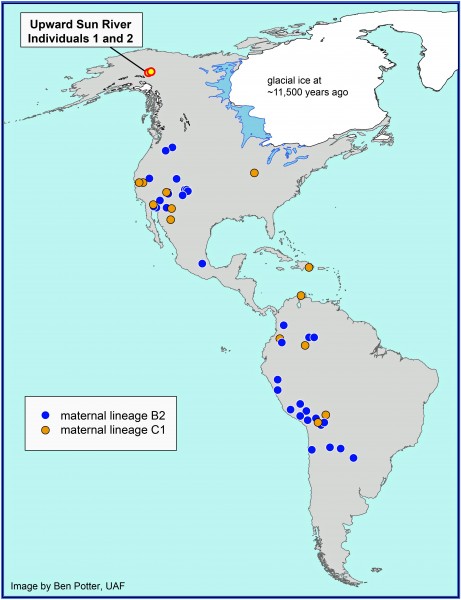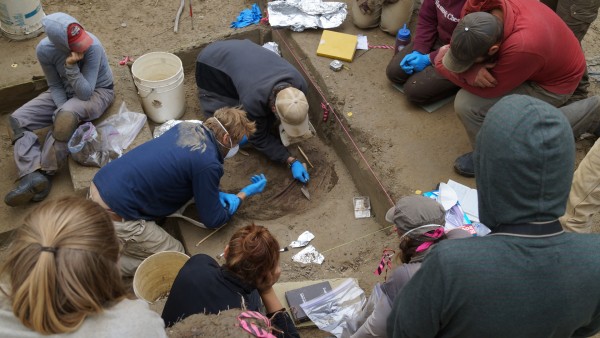Ancient Alaska infants' DNA supports human migration theory
October 26, 2015
Naomi Horne
907-474-6464

Analysis of genetic material from the remains of two ice age infants discovered in Alaska has revealed connections to two ancient lineages of Native Americans, according to a paper published this week in the Proceedings of the National Academy of Sciences.
Researchers in Alaska and Utah have documented that the infants had different mothers and were descended from two distinct lineages not previously identified in the Arctic.
University of Alaska Fairbanks archaeologist Ben Potter and University of Utah geneticists Dennis O’Rourke and Justin Tackney deciphered ancient mitochondrial DNA from two infants buried in Alaska 11,500 years ago. The burials represent the oldest human remains ever found in northern North America.
Potter and a team of anthropology faculty members and students working at the Upward Sun River site in Interior Alaska discovered remains of a cremated 3-year-old in 2010, followed by the two infants in 2013. The site and its artifacts provide new insights into funeral practices and other rarely preserved aspects of life among people who inhabited the area thousands of years ago, according to Potter.
"Taken collectively, these burials and cremation reflect complex behaviors related to death among the early inhabitants of North America," Potter said.
While three different children were found, Potter said, the 3-year-old left no preserved genetic material to analyze. The two infants were found to have different mothers, each descended from the genetic root of two different Native American lineages.
“These infants are the earliest human remains in northern North America and they carry distinctly Native American lineages,” said O’Rourke, a senior author on the paper. “These genetic variations had not previously been known to have existed this far north and speak to the early genetic diversity of the time.”

The research supports the theory that this community descended from an earlier Beringian population, O’Rourke said.
“You don’t see any of these lineages that are distinctly Native American in Asia or even Siberia, so there had to be a period of isolation for these distinctive Native American lineages to have evolved away from their Asian ancestors. We believe that was in Beringia,” O'Rourke said.
The Upward Sun River infants are among human remains at only eight sites in North America older than 8,000 years from which researchers have obtained mitochondrial DNA, genetic information inherited only from mothers. Tackney, the paper’s lead author, said all five major Native American lineages have been found in these eight sites.
“That indicates they were present in the early population in Beringia that gave rise to all modern Native Americans," Tackney said.
The study authors said analyzing the DNA of ancient individuals helps us understand how the Western Hemisphere was colonized and populated.
“The children also appear to have died during summer months when food should be the most plentiful," Potter said. "This may indicate more resource stress than we have previously thought.”
The children were buried with valuable items from their time, providing a rare window into the ideologies and beliefs of the ancient Beringians. Grave goods included decorated, hafted dart points and foreshafts, likely used to hunt large game like bison and elk.
“Having access to these types of organic artifacts preserved and available for research will greatly advance our knowledge of early weapon systems in North America,” said Joshua Reuther, curator of archaeology at the University of Alaska Museum of the North and a coauthor of the study.
Excavations of the site revealed human dwellings as well as animal remains, indicating a broad diet that included large and small mammals and, interestingly, fish. Potter and others identified these as chum salmon in a paper published by the same journal last month. The fish remains confirmed the earliest human use of salmon in North America. Researchers continue to explore the ancient lifeways reflected at this and other nearby sites.
Potter said these findings also lead to a better understanding of how ancient Native Americans adapted to dynamic climate conditions in the Arctic, the stressors they faced and how they engaged with their environment.
“Understanding human relationships to their environment in the ice age allows us to more accurately explore modern effects of climate change on human systems,” Potter said. “This new genetic analysis allows us to further understand the human capacity to deal with changing landscapes and natural resources as they and related populations expanded into the New World.”

Potter and his team continue to collaborate with local and regional Alaska Native groups, including the Tanana Chiefs Conference. The excavation and analysis were funded in part by the National Science Foundation.
O’Rourke, Tackney and Potter conducted the study with University of Utah personnel Michael Powers, W. Scott Watkins and Derek Warner; UAMN archaeologist Reuther; Liverpool John Mores University bioarchaeologist Joel Irish; and University of Kansas anthropologist Jennifer Raff.
ON THE WEB: www.uaf.edu/anthro/, www.uaf.edu/cla, www.uaf.edu/museum
ADDITIONAL CONTACTS: Ben Potter, UAF archaeologist, 907 474-7567, bapotter@alaska.edu; Joshua Reuther, UAMN archaeology curator, 907-474-6945, jreuther@alaska.edu.
NOTE TO EDITORS: Photos are available for download at //news.uaf.edu/upward_sun_river_dna/. A copy of the paper is available by contacting Horne or the authors.


